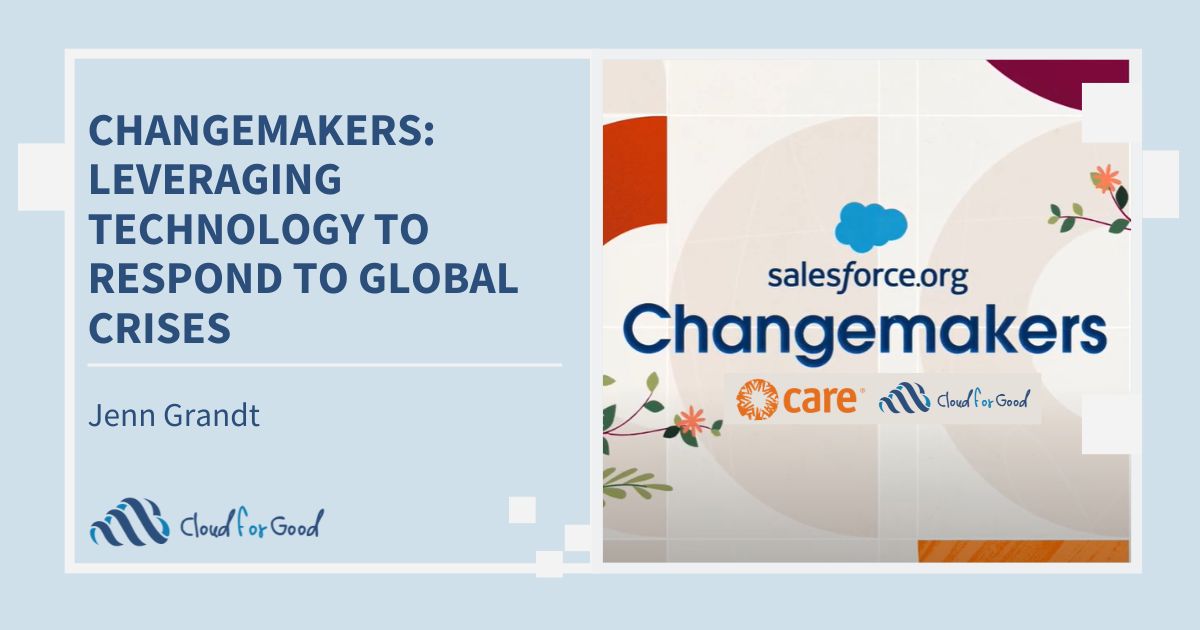Over the past few years, nonprofit organizations have been at the forefront of change. From responding to a global pandemic to standing up for equality and reacting to ongoing geopolitical forces, our nonprofits are leading the charge in bettering our communities. Salesforce.org recently highlighted both Cloud for Good and CARE, a nonprofit organization seeking to save lives, defeat poverty, achieve social justice, and fight for women and girls, as part of the Changemakers video series.
Hosted by Salesforce.org Chief Customer Officer Rob Acker, Cloud for Good Founder & CEO Tal Frankfurt and CARE Head of Corporate Partnerships Chris Noble discussed the strategies and technologies that help them be nimble enough to respond to emergency campaigns, create change regularly, and the lessons they have learned along the way. CARE’s partnership with Cloud for Good has helped them leverage technology to transform their business operations and create a direct impact for women and girls in over 100 countries, helping over 250,000 people each year.
Shifting Quickly to Support International Crises
Since 2020, the global community has seen geopolitical uncertainty and a pandemic. Nonprofits have had to shift quickly to respond and pivot using the technology that’s available to them. Salesforce’s nonprofit platform helps these organizations deliver services quickly and efficiently and measure the results. Looking back at the lessons learned and what made these global campaigns successful, we can better strategize around future social and political crises.
Supporting the Global Community to Create a Lasting Impact
One of the most critical and well-known international crises today is happening in Ukraine. Over 14 million people, primarily women and children, have fled to other countries or locations inside Ukraine and are currently unsheltered. To support this refugee population, CARE (an international humanitarian nonprofit) leverages and mobilizes its network of donors through Salesforce to support programs that restabilize communities and provide food, shelter, financial access, and jobs.
Chris Noble, Head of Corporate Partnerships at CARE, points out that CARE started as a US-based organization that sent packages of goods and rations to war-torn Europe during WWII (where the term care package came from). They now work to help women and girls in over 100 countries by launching programs in local communities that have a direct and long-lasting impact. For example, they started a community-driven savings and loans program to help offset displacement costs or provide the funds needed to create a new business. Internationally, women have built up over $12 million in shared savings with the goal of $50 million by 2030.
In countries with high populations of Ukrainian refugees, CARE launched classrooms with Ukrainian-speaking teachers, so children can have a sense of normalcy and so mothers, grandmothers, and relatives receive a needed break from the children. Working within the local communities helps build resiliency so communities can not only recover but thrive after a crisis.
Effective Fundraising and Impact Measurement With Data
With the world watching the news about Ukraine in the mainstream news, many organizations are receiving a windfall of donations to help. But not all organizations have the infrastructure or staffing necessary to track donations, follow up, and further mobilize their audience.
Noble says it can be problematic, but technology can help. “It’s hard to take that big pile of data and respond promptly. The Salesforce platform, in particular, has been helping us address those issues for quite a while. But even more recently, our partnership with Cloud for Good enabled us to respond and segment and help manage that influx of new donors.”
Tal Frankfurt, Founder/CEO of Cloud for Good, agrees. Cloud for Good’s mission is to help nonprofits create positive change in the world by supporting them with technology. They have worked with over 2,500 nonprofit organizations and higher education institutions in the past decade and now partner with CARE to provide campaign and fundraising services.
“When we needed to run an emergency campaign around Ukraine, within hours, we were able to pull tens of thousands of names that resulted in millions of dollars of immediate gifts from donors,” notes Frankfurt.
Engaging Corporate Partners and Stakeholders Through Technology
According to Frankfurt, the mindset around technology is changing. Organizations want to understand their stakeholders so they can provide better services, raise money, measure their impact, and expand their work. At CARE, impact measurement is critical. Data, along with instant access to their donors, helps them act quickly. They can improve their strategy by analyzing their campaigns and building on their successes.
CARE’s humanitarian efforts inside Ukraine have piqued some interest from corporate sponsors looking at what they can do next in countries like Poland, the Czech Republic, and Moldova – all places where the refugee crisis may linger. By quickly mobilizing its donor base, CARE can show corporate partners that they are taking the proper steps to have a noticeable effect on the communities they serve and that there is support for their programs.
While much of the current focus is on building up the communities that have been destabilized in Ukraine, many other countries are experiencing similar crises. Noble points out that perhaps since so many more people are aware of what’s going on in Ukraine, it can spotlight other countries like Afghanistan and Syria, and compel people to help support their efforts in those countries, too.





